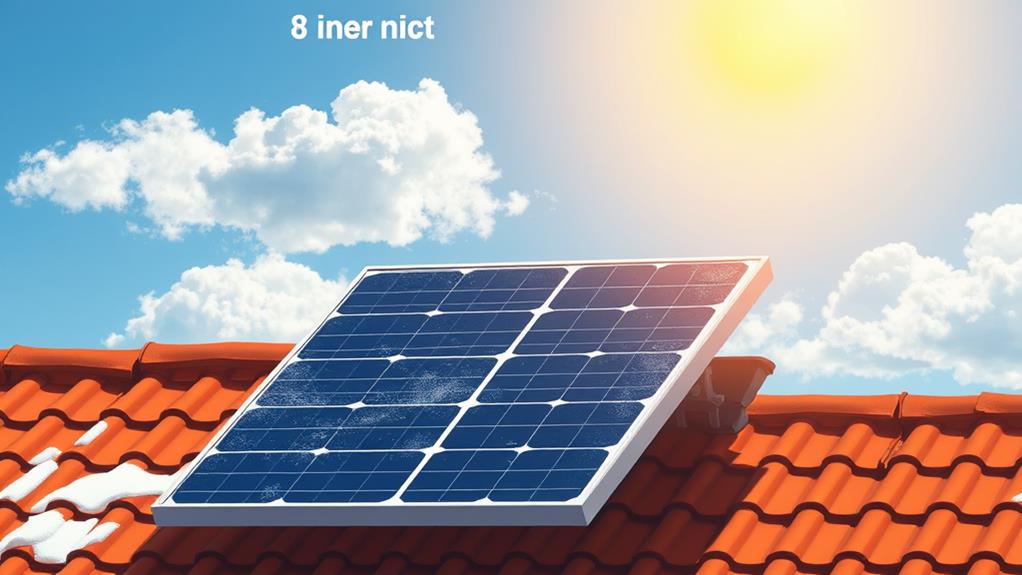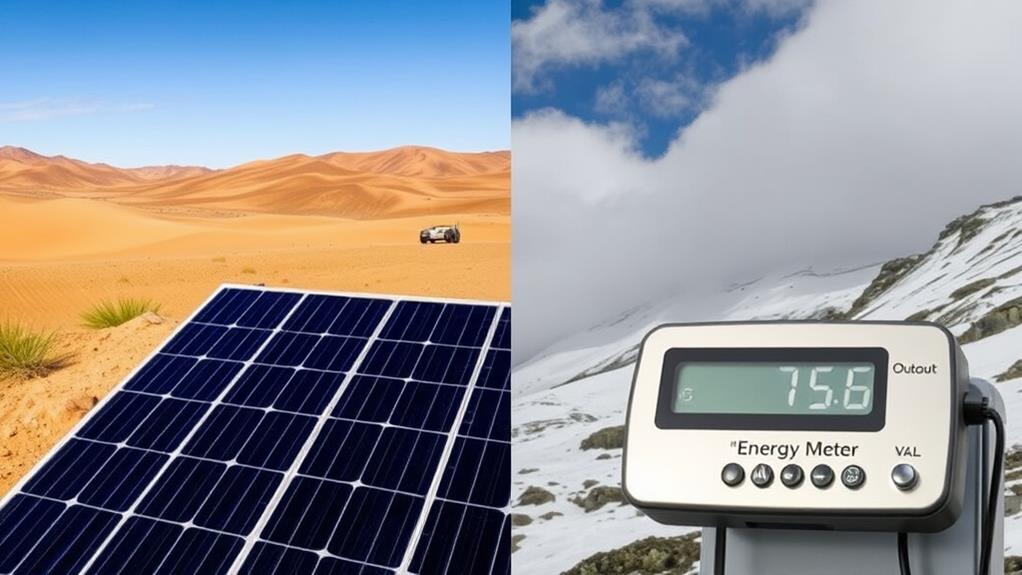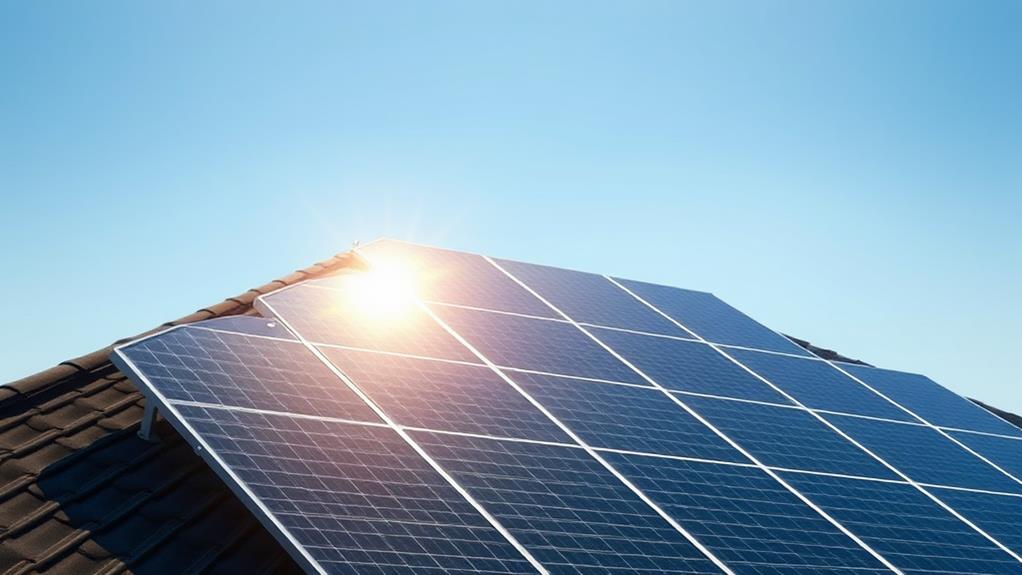Imagine a ship's sail adjusting to catch the most wind; similarly, your solar panel's daily kWh output hinges on several key factors. On average, a typical panel produces between 1 to 4 kWh per day, but this number isn't set in stone. It varies based on the panel's type, your geographic location, and even the angle at which it's installed. You'll find that monocrystalline panels generally perform better, especially in sunnier regions. But how do weather and seasonal changes come into play, and what can you do to optimize your setup?
Factors Affecting Solar Panel Output

Several essential factors can greatly influence the output of a solar panel. To maximize solar efficiency, you need to take into account the angle and orientation of the panels. Positioning them to capture maximum sunlight throughout the day is vital.
The geographical location also plays a major role; areas closer to the equator generally receive more sunlight, thereby enhancing energy conversion rates.
Weather conditions are another key element. Clear, sunny days allow for ideal energy conversion, while cloudy or rainy days can greatly reduce output. Additionally, the presence of shading from trees or buildings can negatively impact the amount of sunlight reaching the panels, consequently lowering solar efficiency.
Solar panels can be used in diverse applications across residential, commercial and industrial sectors.
The type of solar cells used is important as well. High-efficiency cells can convert more sunlight into electricity, boosting overall output.
Regular maintenance, including cleaning the panels to remove dirt and debris, is necessary to guarantee they operate at peak efficiency.
Types of Solar Panels
Understanding the types of solar panels available is just as important as knowing the factors that affect their output. You need to choose between monocrystalline panels and polycrystalline panels based on your specific energy goals and constraints.
Monocrystalline panels, made from a single crystal structure, offer high efficiency rates—typically between 15-20%. They're your go-to if you're limited on space but require maximum output. These panels tend to perform better in low-light conditions and have a longer lifespan, often surpassing 25 years. Additionally, they're built with tempered glass and corrosion-resistant framing for durability in harsh weather.
On the other hand, polycrystalline panels are constructed from multiple silicon crystals. While they're generally less efficient, with rates around 13-16%, they're also more cost-effective. If you have ample installation space and a tighter budget, polycrystalline panels might be the right choice. They tend to have a slightly shorter lifespan compared to monocrystalline panels but still provide a durable, reliable energy solution.
When deciding between these two types, consider your space, budget, and long-term energy needs. Both types offer unique advantages that can be tailored to fit your specific situation, giving you the freedom to optimize your solar energy setup.
Geographic Location Impact

Your geographic location greatly impacts the daily energy output of your solar panels. Solar insolation, or the amount of solar radiation received per unit area, varies considerably depending on where you live. In regions closer to the equator, like Arizona or California, solar panels receive more direct sunlight throughout the year, leading to higher energy production.
Conversely, areas at higher latitudes, such as Alaska or Northern Europe, receive less consistent sunlight, which reduces the potential kilowatt-hours (kWh) generated daily. The transformative potential of solar energy can be especially important in regions with higher insolation rates.
Additionally, advancements in solar technology continue to improve efficiency, making solar energy a viable option in various climates.
Local climate also plays a vital role in solar energy production. If you reside in a region with a mainly clear and sunny climate, your solar panels will perform at their best, maximizing energy output.
However, if your area experiences frequent cloud cover or heavy precipitation, this will diminish the effectiveness of your solar panels. Data indicates that solar panels in sunny climates can produce up to 30% more energy compared to those in less favorable weather conditions.
Weather and Seasonal Variations
Factoring in weather and seasonal variations is crucial when evaluating the daily energy output of solar panels. You need to take into account how cloud cover considerably impacts solar efficiency. On overcast days, the panels can produce only 10-25% of their typical output. In contrast, clear skies maximize energy capture.
Analyzing long-term weather patterns in your area helps you predict the average daily kWh production more accurately. Solar irradiance, which measures power per unit area from the Sun, profoundly influences energy conversion potential and should be included.
Temperature effects also play a critical role. Solar panels function best at around 25°C (77°F). For every degree above this, efficiency can drop by approximately 0.5%. So, in hotter climates, you might notice a decrease in daily output during peak summer months.
Conversely, colder temperatures can slightly improve performance, though the amount of sunlight in winter is typically reduced due to shorter days and low sun angles.
Seasonal variations mean you should expect higher outputs during summer and lower during winter. This fluctuation is due to the sun's position and daylight duration.
Installation Angle and Orientation

The installation angle and orientation of solar panels are essential factors that directly impact their daily energy output. By adhering to installation best practices, you can greatly enhance the efficiency of your solar panels.
The ideal angle for solar panels usually corresponds to your latitude. For instance, if you're at a latitude of 30 degrees, tilting your panels at the same angle guarantees maximum sunlight exposure throughout the year. This approach balances seasonal variations, maximizing energy production.
For those interested in installing solar systems for homes, businesses, or farms, professional services can guarantee ideal angle and orientation.
Orientation optimization is equally important. In the Northern Hemisphere, south-facing panels capture the most sunlight, while in the Southern Hemisphere, north-facing panels are ideal. Adjusting the angle based on seasonal changes can further refine performance. For example, a steeper angle during winter maximizes energy capture when the sun is lower in the sky.
Data from the National Renewable Energy Laboratory (NREL) indicates that proper installation angle and orientation can boost energy output by 20-30%.
Don't overlook shading analysis either; even partial shading can cut output considerably. By following these guidelines, you can harness the full potential of your solar panels, contributing to both energy independence and sustainability.
Conclusion
To summarize, a solar panel's daily kWh production hinges on several variables. Notably, monocrystalline panels can achieve up to 22% efficiency, making them a top choice for maximizing output, particularly in sunny regions. You'll need to take into account geographic location, weather, and the installation angle to optimize energy generation. Proper planning and selection can greatly impact your energy yield, ensuring you make the most out of your solar investment.
